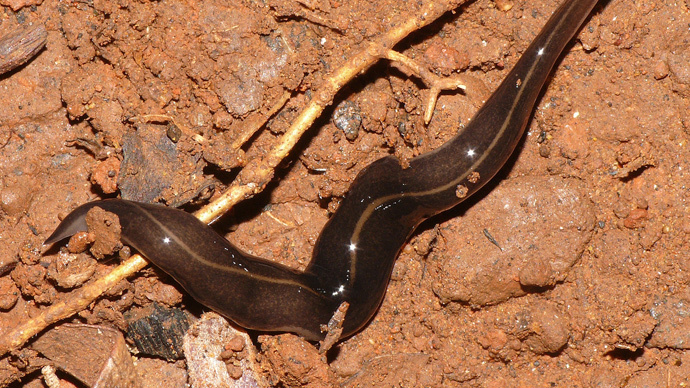Highly invasive snail-eating flatworm found in US for first time

An unsightly worm with a mouth in the middle of its belly, considered to be one of the world's “worst invasive species,” has been discovered in the US for the first time, making its home in several Miami gardens.
In addition to Florida, the creepy-crawly New Guinea flatworm has also been found in five other new locations: New Caledonia, the Wallis and Futuna Islands, Singapore, the Solomon Islands, and Puerto Rico, according to a study published in the journal PeerJ on Tuesday.
The flatworm is unlikely to be received with open arms, as its slithery slug-like appearance isn't exactly appealing.
READ MORE: Plague of Astrakhan: Locust swarm blots out the sun in Russian region (VIDEO)
But the worm's unsightliness isn't the only problem. The species, officially known as Platydemus manokwari, poses a major threat to the Earth's snail biodiversity – quite simply because it loves to eat them.
Using a mouth located in the middle of its belly, the creature wraps itself around snails and ingests them.
That hunger makes the flatworm “a danger to endemic snails wherever it has been introduced,” according to the study.
The threat is so serious that the Invasive Species Specialist Group of the International Union for Conservation of Nature (IUCN) has listed it among the 100 worst invasive species in the world.
The worm is also a threat to other animals that eat snails, including birds. It could even affect plant-life, as certain weeds that usually get eaten by snails may spread and become overgrown if the snail population dwindles.
The worm can also be harmful to humans. According to study author Jean-Lou Justine, a researcher at the National Museum of Natural History in Paris, the creatures produce “dangerous chemicals and release them with their mucus, which is a protection against possible predators.” Those chemicals “can be toxic and could induce allergic reactions,” he said, as quoted by Newsweek.
Originally from New Guinea, the worm has so far been detected in 15 countries, including as far away as France. In its native New Guinea, the worm is found in high-elevation areas that aren't very cold. Researchers believe it probably arrived in Florida in or around 2012.
READ MORE: Pink-tongued, green alien-like worm creates a buzz in Taiwan and worldwide (VIDEO)
This means it probably won't find its way to the extreme northern US or Canada. It's also unlikely to infiltrate deserts or the Rocky Mountains, as it prefers areas with soil and plants. But anywhere else in the Americas is likely fair game.
The Americas also provide more opportunities for the creature, because it won't face the same limitations as it does on various islands. For instance, there is no customs or quarantines across the mainland US, and transport isn't reliant on boats or planes.
“Until now infested territories were mostly islands and the spread of the species from island to island is limited,” the study states.
The flatworm can “easily be passively spread with infested plants, plant parts and soil,” it adds.
Once the worm is in a certain area, it is difficult to halt its spread – particularly because of its small size, and the fact that it lives in the soil.
The New Guinea flatworm measures two inches (50mm) long and .2 inches (50mm) wide. It has a pale white belly, an elongated head, and two black eyes. It lives on the ground, but is able to crawl up trees.












